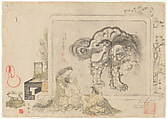Mother and her Children in Front of a Freestanding Screen of a Chinese Lion
Kitagawa Utamaro 喜多川歌麿 Japanese
Toriyama Sekien 鳥山石燕 Japanese
Toriyama Sekichūjo 鳥山石仲女 Japanese
Not on view
In this domestic scene, an oversize freestanding screen features a “Chinese lion” (karajishi), monstrous in size but completely lacking in ferocity, scratches its head with its hind paw while holding a large white peony in its mouth. The picture-within-a-picture was executed in bold, thick ink outline strokes by Toriyama Sekien, a Kano trained artist. The aristocratic lady and her two children reacting in awe to the dynamic painting of a mythological beast were created by Sekien’s most famous pupil—the ukiyo-e print artist Kitagawa Utamaro, renowned for his images of beautiful women of the demimonde. Partly hidden behind the screen to the right, a wooden bucket holds branches of cherry blossoms, created by Toriyama Sekichūjo, a female pupil of Sekien.
Seikien’s playful depiction of a Chinese lion likely alludes to a famous legend about a Japanese monk journeying to China to seek enlightenment who has a miraculous vision of a lion, associated with the Bodhisattva of Wisdom, Manjusri, frolicking in a field of peonies. Delineated in the Kano style, the image may also allude to Sekien’s role as a revered master able to transmit the secret teachings of ink painting to followers like Utamaro and Sekichūjo. Whatever the rationale, the surimono commemorates Sekien’s turning seventy-five, and celebrates a special connection between the master and two of his pupils.
The setting is luxurious, suggesting that the work was made at the behest of a wealthy patron, probably on behalf of the elderly artist Sekien. The mother—dressed in elegant courtly garb and wearing her hair in long, flowing tresses—comforts her little son and his older brother as they react with fear to the oversize picture of a lion, as if this fabulous beast had come to life. Depicted to the left of the freestanding screen is an inlaid lacquered table adorned with a table screen and a bronze vase holding peacock feathers. Beside it is a low lacquered desk with a sheaf of writing paper held in place by a rabbit-shaped paperweight. On the far right, a wooden bucket behind the screen holds branches of cherry blossoms, indicating the season is late spring.
This exceedingly rare surimono (privately published woodblock print) to my knowledge is the only surviving impression and documents a remarkable collaboration between Sekien and two of his pupils who eventually moved beyond the traditional painting styles of the Kano school to distinguish themselves in the Ukiyo-e school. This surimono may be a considered a certificate of transmission of artistic teachings between generations. The master Sekien had been a dedicated student of Gyokuen Chikanobu, an adherent of the conservative Kano school in Edo of eighteenth century, but who, through producing designs for printed editions of popular literature and ghost stories, developed close links with Ukiyo-e school artists and publishers. Important also, were the connections that both Sekien and Utamaro would have to poets in popular poetry circles—both 17-syllable haikai and 31-syllable witty kyōka verse—of the late nineteenth century. That this particular impression once belonged to poet, essayist, and great literary arbiter Ōta Nanpo (Shōkusanjin), as demonstrated by the collector’s seal, further attests to remarkable cultural networking this print represents
Due to rights restrictions, this image cannot be enlarged, viewed at full screen, or downloaded.

